Excuse me if this isn't the correct forum but I've acquired these early 80s three-way speakers as part of a bundle deal. They are either some store brand or potentially white van called "AudioLinear." I was considering just trashing these but decided to install my patented TempSurround™ and give one a listen and they seem to work well enough regardless of the glue that's dripped all over everything. So I've decided to install some actual surrounds but is there anything else I should do to these? They come full featured with dome tweeter styled "port", "crossover" caps, a nifty circuit breaker and that cool light up panel with some neato (they actually are) 8 ohm potentiometers. So here's my question, assuming time and labor is not a factor, is it worth doing any sort of upgrade or changes to these like putting in actual crossovers or installing damping material etc? I don't want to spend much money, frankly I thought the surrounds and gaskets were spending too much but here we are....
Attachments
-
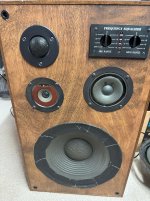 front.jpg649.4 KB · Views: 117
front.jpg649.4 KB · Views: 117 -
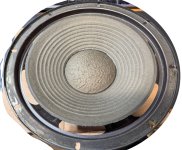 woofer_front.jpg691.1 KB · Views: 104
woofer_front.jpg691.1 KB · Views: 104 -
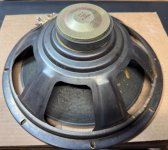 woofer_back.jpg531.2 KB · Views: 87
woofer_back.jpg531.2 KB · Views: 87 -
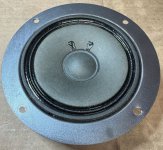 mid_front.jpg886.1 KB · Views: 87
mid_front.jpg886.1 KB · Views: 87 -
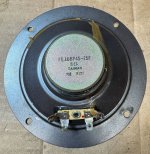 mid_back.jpg1,017.4 KB · Views: 84
mid_back.jpg1,017.4 KB · Views: 84 -
 tweeter_front.jpg563 KB · Views: 85
tweeter_front.jpg563 KB · Views: 85 -
 tweeter_back.jpg902.2 KB · Views: 89
tweeter_back.jpg902.2 KB · Views: 89 -
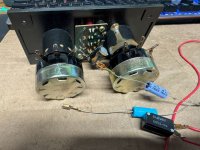 components.jpg601.5 KB · Views: 93
components.jpg601.5 KB · Views: 93 -
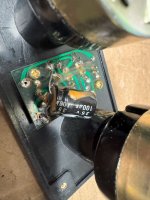 eq_detail.jpg391.4 KB · Views: 90
eq_detail.jpg391.4 KB · Views: 90 -
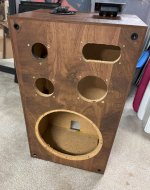 cabinet.jpg513.6 KB · Views: 101
cabinet.jpg513.6 KB · Views: 101
I presume the 8 ohm "potentiometers" are actually constant impedance L-pad controls.
It may be worth installing fresh new bipolar electrolytic capacitors but, looking at the quality of the drivers, it is probably not worth redesigning the crossover.
I'm not clear on whether this is a ported or sealed enclosure. If the former, you may like to experiment with the thickness of the absorbent material attached to the enclosure walls. If the latter, you may like to experiment with the quantity of absorbent material that is filling the entire enclosure.
It may be worth installing fresh new bipolar electrolytic capacitors but, looking at the quality of the drivers, it is probably not worth redesigning the crossover.
I'm not clear on whether this is a ported or sealed enclosure. If the former, you may like to experiment with the thickness of the absorbent material attached to the enclosure walls. If the latter, you may like to experiment with the quantity of absorbent material that is filling the entire enclosure.
That dome tweeter in the top left is a dummy and just an open port so you could call these ported but I could also seal that hole if it makes sense since there's no actual tube behind the hole. There is currently no sound deadening whatsoever, just pure, particle board bliss.
Adding damping material definitely seems worthwhile. The most effective tends to be absorption/denser material near the walls and fluffier fill inside. But any should be better than none.
Adding bracing is something else that's probably worth doing. Just do what you can through the woofer hole. Some brace ideas below, though you can obviously add more than these if you're in the mood:
https://www.stevemeadedesigns.com/board/topic/202148-best-way-to-brace-a-box/

https://community.klipsch.com/index.php?/topic/198790-chorus-bracing/

Adding bracing is something else that's probably worth doing. Just do what you can through the woofer hole. Some brace ideas below, though you can obviously add more than these if you're in the mood:
https://www.stevemeadedesigns.com/board/topic/202148-best-way-to-brace-a-box/
https://community.klipsch.com/index.php?/topic/198790-chorus-bracing/
Last edited:
It is a big baffle.
I should make a new box and fit it all in that.
Speakers benefit from some narrow baffle.
I should make a new box and fit it all in that.
Speakers benefit from some narrow baffle.
Is the point of bracing to lower resonance like sound dampening does? I didn't take good pics of the box but there is some bracing between adjacent panes by just having a piece of wood glued into the corner of those pieces but if the idea is to attach the bracing as closely to the center of the panel for the purpose of lowering vibration, those aren't doing anything then....Adding bracing is something else that's probably worth doing. Just do what you can through the woofer hole. Some brace ideas below, though you can obviously add more than these if you're in the mood:
Well the point is kind of to leave them somewhat original at least outwardly since they're so wild looking. I know nothing will be ideal in any sense but cutting down on some resonance seems like a good idea if I can do it on the cheap.It is a big baffle.
I should make a new box and fit it all in that.
Speakers benefit from some narrow baffle.
I could also seal that hole if it makes sense since there's no actual tube behind the hole.
There doesn't have to be a tube - the thickness of the baffle itself forms the length of the port in this large box.
I would leave the port cover in place and treat the enclosure as a reflex design,
Since the baffle is large and subject to vibration then, provided there is room, I would install a horizontal brace situated between the top of the woofer and the two small drivers immediately above.
Is the point of bracing to lower resonance like sound dampening does?
Bracing of the cabinet walls stiffens the enclosure and helps raise the frequencies of its resonances above the range of the frequencies pumped into it by the woofer.
Absorbent material helps to minimise internal air resonances caused by sound waves reflected off the internal walls of the enclosure. It does so by converting sound energy into heat. I'm talking about a ported enclosure here.
Last edited:
Horizontal from side to side or front to back or both? I have enough room to do both. Should they be glued to eachother as well?Since the baffle is large and subject to vibration then, provided there is room, I would install a horizontal brace situated between the top of the woofer and the two small drivers immediately above.
Both - an open horizontal shelf - not a solid divider.

P.S. Just to be clear, if treating this as a ported enclosure, it is normal to only attach absorbent material to the internal walls (except the front baffle). This arrangement, along with an open brace, allows the woofer to communicate with the reflex port without impediment.
P.P.S. Also see mattstat's final image.
P.S. Just to be clear, if treating this as a ported enclosure, it is normal to only attach absorbent material to the internal walls (except the front baffle). This arrangement, along with an open brace, allows the woofer to communicate with the reflex port without impediment.
P.P.S. Also see mattstat's final image.
Last edited:
I think I have a bunch of 1x1s lying around I could cut to length. I assume then that if I can do the pieces along the baffles, that is more ideal than a simple cris-crossed brace without the "edges" of the frame so to speak... Is it ok for the bracing to be affixed to the front baffle or would I leave that side with a little space behind the baffle and leave it unglued?
Is there some reason I can't quote the last person who commented? @stocktrader200 - cheaper to put a new woofer in than what? Do nothing? I'm looking to either leave things alone or make improvements that don't have much cost. I have scraps of wood and glue lying around...
Yes.Should they be glued to eachother as well?
Yes, it has been removed to improve the flow of a thread. If you have a real need to quote, simply select part of the text and it will become available to quote.Is there some reason I can't quote the last person who commented?
It may be cheaper to put a new woofer in.
Before doing that , disconnect the woofer and listen to the other three drivers. If it isnt smooth then the woofer alone wont fix it.
Cheaper then to refoam the old woofer
Before doing that , disconnect the woofer and listen to the other three drivers. If it isnt smooth then the woofer alone wont fix it.
Cheaper then to refoam the old woofer
There could be also buyers on the net looking for those drivers.
The phenolic ring tweeter or the dome mid.
The foam rings might be able to buy separately for less than a typical kit.
Assuming you have the right glues on hand.
Otherwise after a trip to the hardware store to get the glues.
Correct a reform kit around 30 dollars could just buy Dayton Classics.
Which will outperform what is in there anyways.
I would redo the baffle for a vertical arrangement with tighter center to center
Otherwise if no re engineer of the system
A simple way to get it going would be replace the old electrolytic bipolar caps
with new bipolar caps.
The duct tape surrounds dont fit most bills, I think a refoam is needed before they are damaged.
Of course wont deny using the same patent for a few speakers in my early years.
Im glad you trade marketed the technique. LOL love it looks like fun.
The phenolic ring tweeter or the dome mid.
The foam rings might be able to buy separately for less than a typical kit.
Assuming you have the right glues on hand.
Otherwise after a trip to the hardware store to get the glues.
Correct a reform kit around 30 dollars could just buy Dayton Classics.
Which will outperform what is in there anyways.
I would redo the baffle for a vertical arrangement with tighter center to center
Otherwise if no re engineer of the system
A simple way to get it going would be replace the old electrolytic bipolar caps
with new bipolar caps.
The duct tape surrounds dont fit most bills, I think a refoam is needed before they are damaged.
Of course wont deny using the same patent for a few speakers in my early years.
Im glad you trade marketed the technique. LOL love it looks like fun.
Is it ok for the bracing to be affixed to the front baffle
The bracing requires to be fixed to the front baffle - and to the sides and back of the enclosure to form a solid structure.
- Home
- Loudspeakers
- Multi-Way
- AudioLinear Speaker Restoration